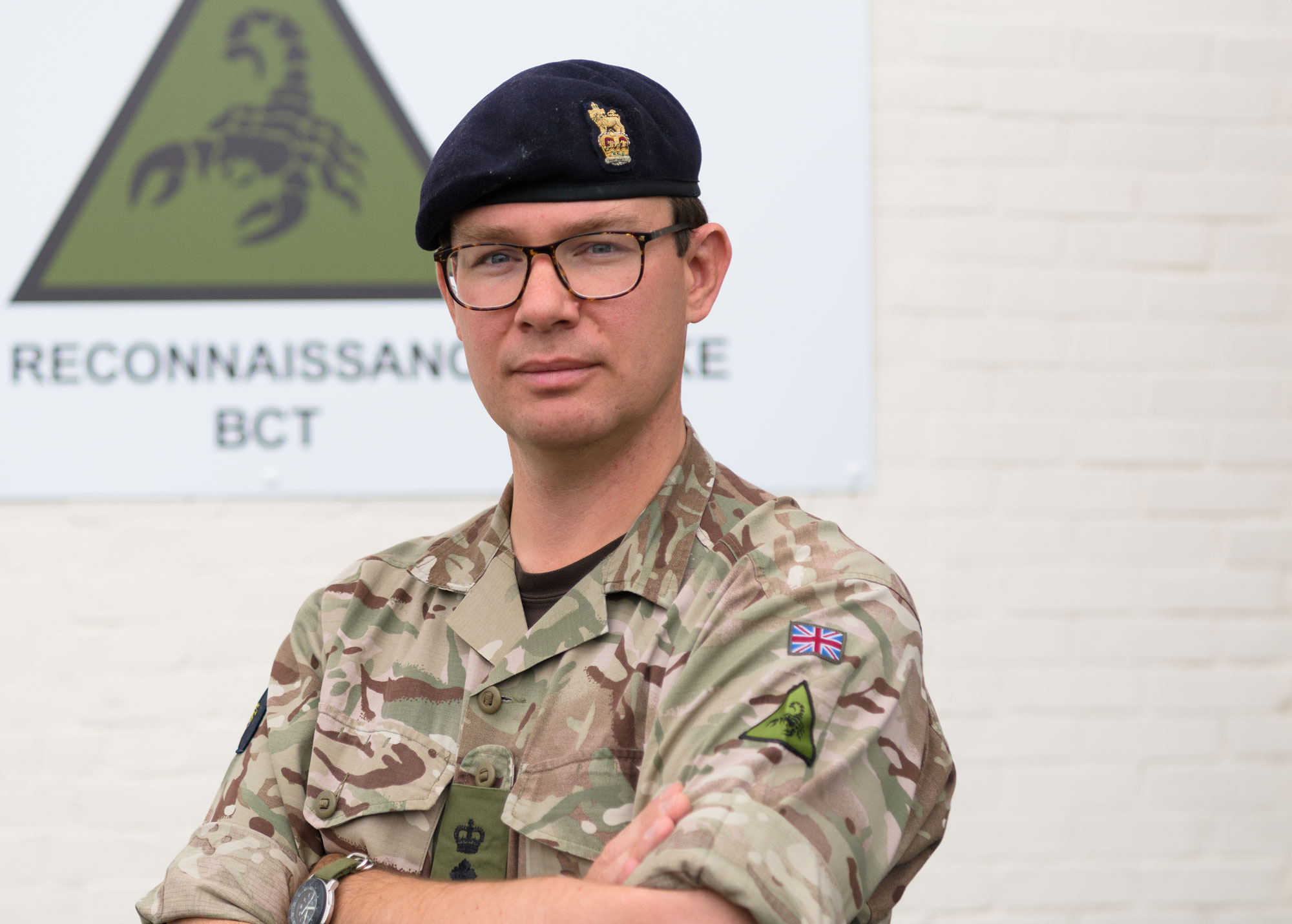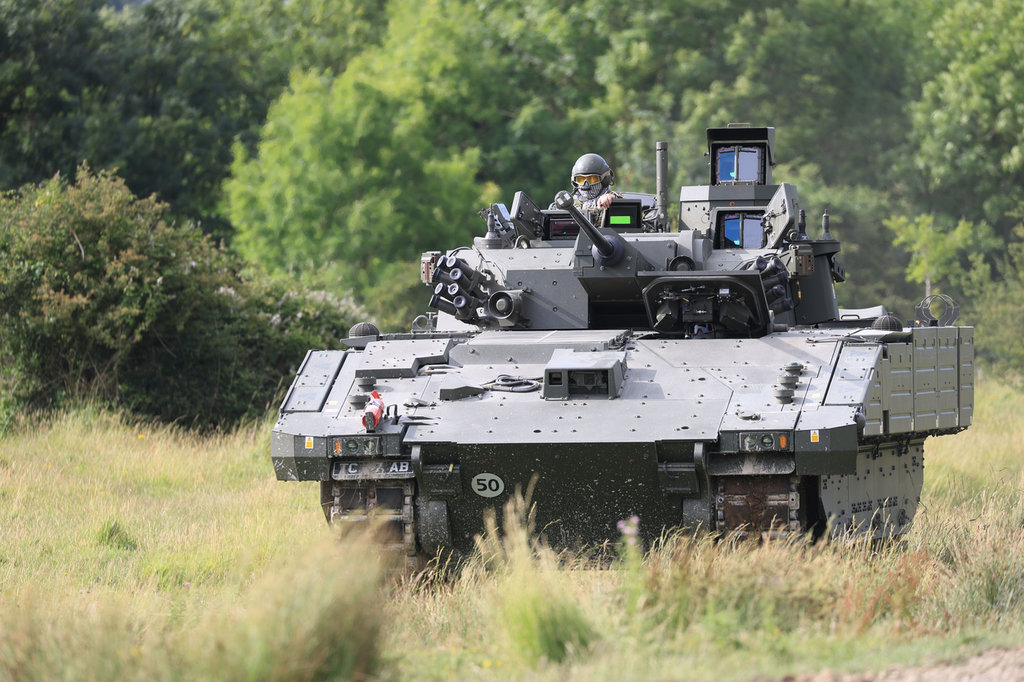Feature
Agile approach: British Army Deep Recce Strike
Harnessing advanced technology and streamlining command, the British Army's 1st Deep Recce Strike (DRS) Brigade Combat Team redefines modern warfare. Andrew Salerno-Garthwaite reports.

Brigadier Neil Budd commands the 1st Deep Recce Strike Brigade Combat Team, combining reconnaissance, electronic warfare effects and deep fires to provide long range persistent surveillance and long-range precision strike capabilities. Photo courtesy of MoD.
T he integration of military capability is a key influence for force modernisation, with the British Army also making moves to adapt how to structure its units to better deliver effect where needed.
The IISS report, ‘The Future of NATO’s European Land Force: Plans, Challenges, Prospects’, identifies current and planned investments in rocket artillery and surface-to-surface strike as positive steps Nato land forces are taking, reasoning that they should deliver systems capable of engaging targets at longer range than before, such as forces in the rear and enemy logistics and headquarters.
However, the report goes on to say that fully benefiting from these systems ‘depends also on improved training and integration with intelligence and command and control capabilities.’
In July, at a media roundtable for the report, Brigadier (ret) Ben Barry, senior fellow for land warfare at the IISS, expanded on this finding, identifying better integration of precision deep-strike with intelligence as a lesson from the Ukraine War, "not least the proliferation of intelligence gathering by commercial drones”.
“What we've also seen is that by [Ukraine] was very clever and agile networking, including developing new systems and new apps and using Elon Musk's Starlink as a bearer, has been very successful,” he added.
To examine British Army initiatives that would work towards this goal, Global Defence Technology interviewed Brigadier Neil Budd, commander of the 1st Deep Recce Strike (DRS) Brigade Combat Team (BCT), the British Army’s first recce-strike complex.
The DRS BCT is a novel brigade, structured to bring together all the elements required to fight a deep battle for a division-sized force, including artillery, rocket artillery, ground reconnaissance, signals intelligence and electronic warfare, with the aim of increasing integration and building a capability for a more effective deep-strike capability than a larger opposing enemy force.
“If we, as a Western organisation, go toe-to-toe with Russia in an asymmetric fashion, like an artillery barrage, we're not going to do particularly well, because they’ve got lots more guns than us, and many of them have got longer ranges. But if we can be really intelligent about the way we do our business, and we blind them and we deafen them first,” says Budd, referencing approaches to limiting enemy sensors through electronic warfare and other means, “then having done that we can then take their system apart”.
“And our business is to basically attack their kill-chain. If I can take out those eyes and brain, so that the guns and rockets become, in effect, just dumb lumps of metal, because they don't know where to point at, and they don’t know when to fire, then I can take it apart quite quickly.”
The effects-guidance matrix
Recce-strike attacks in the past took place through the orchestration of separate brigades for artillery, armoured cavalry ground-based reconnaissance, acoustic and radar sensors, and unmanned aerial systems. The logic of the DRS BCT sees this as an impediment, as having these assets in separate brigades “meant that whenever you wanted to bring them together to deliver a coherent effect, to build a recce-strike complex, you always had to go up the chain of command and then go back down again to make something happen,” says Budd.
I set the command parameters, and that means that I can delegate more and more. You don’t have to go up the chain of command then come down - you can go left and right very fast.
- Brigadier Neil Budd, British Army
In contrast, the new DRS BCT contains elements of all the units required to create a cohesive effect, under one command, with streamlined decision making that takes advantage of networks of troops in the field that understand the effects guidance and can communicate with each other to organise fires. “I set the command parameters, and that means that I can delegate more and more. You don’t have to go up the chain of command then come down - you can go left and right very fast.”
As commander of the brigade, Budd sets out a series of parameters in an effects-guidance matrix, describing the most efficient approach to take to different categories of target, and assigning a level of priority to each kind of target. “Doing all of that, this frees lots and lots of people to be looking through all sorts of different layered sensors, and whoever finds the right target first will be allocated the necessary assets.”

Image of a GMLRS (Guided Multiple Launch Rocket System), seen here being demonstrated at Lulworth Range in the UK. Credit: Cpl Tim Hammond, UK MOD © Crown copyright 2023.
“Even now, as a trooper…if they can perceive the highest priority target on the target-list, then they can be automatically allocated all the associated and necessary assets to deal with that target. Because the way that we’ve set up command is that it’s a network agile command.”
Deep Recce Strike BCT made an impression at Warfighter 23-4
As part of the 3rd Division, the DRS BCT completed the Warfighter 23-4 exercise on 27 April, after two weeks of simulated battlefield operations involving tens of thousands of troops from across the globe. Warfighter 23-4 was a US Department of Defense directed multi-echelon exercise that took a year in the planning, testing US and Nato allied troops across numerous facets of military operations while they simulated large-scale combat operations.
At the start of the exercise Budd found he was making 20 or 30 decisions a day, something he admitted was “quite a lot for a commander to do effectively” but that when the command-and-control matrix was established and people knew what they were doing, he found that he was making three to five decisions a day. “Subordinate commanders had been talking left and right, as it were, making decisions between them … and they would have executed those decisions faster.”
At one stage there was a question as to whether the exercise had been set up incorrectly.
- Brigadier Neil Budd, British Army
The subject of speed has important historical context for the Recce-Strike complex, as Barry discussed at the IISS media round table. During operation Desert Storm in 1991, the 1st Armoured Division attempted a similar integrated design for deep battle but had to abandon the approach because the ground reconnaissance elements were ‘inadequately protected’ says Barry, and unable to keep up with the faster pace of tanks and infantry fighting vehicles.
Where the position of the modern DRS BCT differs in texture from the circumstances of Desert Storm, is that Budd’s cavalry elements today make up the front edge of the division. Being equipped with layered ISR, they are operating drones and detecting enemy activity ahead of other elements in the land forces.

British Army 3rd Division Soldiers inspect a FV510 Warrior Infantry Section Vehicle during the Warfighter Exercise 23-4 at Fort Hood, Texas, April 18, 2023. Credit: US Army photo by Sgt. Luis Santiago
With the long-range rockets available to the team, assets are available to range out to the forward deployed reconnaissance forces, and the command-and-control structure enables balance between competing requirements while the rest of the division is pulled forward.
The efficacy of the DRS-BCT has been demonstrated in exercises with impressive results. During the major combat operations of Warfighter 23-4, around half of all targets killed were attributed to the recce-strike complex, while most of the remaining destroyed targets were split near evenly between Apache air support and the close armoured brigades. “We were fighting the battle so much further, that we were killing off their radars first - blinding them and deafening them and taking them apart,” says Budd. “At one stage there was a question as to whether the exercise had been set up incorrectly.”
Meshed communications networks
The adoption of advanced technology has made a big difference to the DRS BCT’s ability to build mesh networks, in particular use of modern radios, but the scale of the mesh networks brings a new set of problems. During Warfighter 23-4, while the DRS BCT was “outmatched and outgunned”, where the team was successful it came through higher tempo activity. “We could get inside, and go faster and faster… Our limiting factor now is our people. At one stage we had more messages coming over the radio data network than our signallers could cope with.”
“So, we are looking at AI now. Looking at how you put AI in command systems, and into the processing systems so that when you’ve got data overload, you can get that data sifted, prioritised, and pulling out the stuff that’s most relevant and allowing the logic flow to go faster and faster,” Budd stated.

The Deep Recce Strike Combat Brigade Team features the Household Cavalry regiment with a section mounted on the AJAX armoured fighting vehicle, representing a technological effect change. Credit: Photo by Cpl Tim Hammond, via UK MOD © Crown copyright 2023.